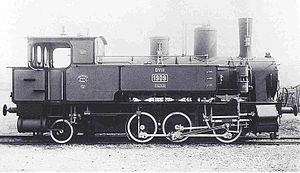Bavarian D VIII
| D VIII (Bavaria), AL No. 1–3, 5 DR series 98 6 ÖBB 891 |
|
|---|---|
|
D VIII 1909 for the Ammerseebahn 1898 at Krauss & Comp.
|
|
| Numbering: | DR 98 661… 679 |
| Number: | 18 (Bavaria); 4 (AL) |
| Manufacturer: | Krauss & Comp. |
| Year of construction (s): | 1888-1937 |
| Retirement: | 1959 |
| Type : | C1 'n2t |
| Gauge : | 1435 mm ( standard gauge ) |
| Length over buffers: | 9,170 mm / 9,670 mm * |
| Service mass: | 43.3 t / 47.5 t * |
| Friction mass: | 36.3 t / 36.7 t * |
| Wheel set mass : | 12.1 t / 12.5 t * |
| Top speed: | 45 km / h |
| Indexed performance : | 315 kW |
| Driving wheel diameter: | 1,006 mm |
| Rear wheel diameter: | 800 mm |
| Number of cylinders: | 2 |
| Cylinder diameter: | 390 mm / 406 mm * |
| Piston stroke: | 508 mm |
| Boiler overpressure: | 12 bar |
| Number of heating pipes: | 186 |
| Grate area: | 1.60 m² |
| Evaporation heating surface: | 89.60 m² / 90.40 m² * |
| Water supply: | 6300 l |
| Fuel supply: | 1.9 t |
| Locomotive brake: | Riggenbach counter pressure brake, compressed air brake |
| * 2nd series | |
The locomotives of type D VIII were wet steam locomotives of the Royal Bavarian State Railways .
history
For the route between Freilassing and Berchtesgaden , which had gradients of up to 40 ‰ and curve radii of up to 180 m, new locomotives were required in 1888. The Munich locomotive factory Krauss & Comp. initially delivered three machines, which were given the track numbers 904-906. The powerful boiler required a running axle , which, based on a proposal by Richard von Helmholtz, was arranged as a trailing axle in the form of a Krauss-Helmholtz steering frame . The wheel set had a side play of ± 31 mm and the last coupling wheel set ± 25 mm, the coupling pins were spherical and the coupling rod on the drive pin was provided with a universal joint. Equipped in this way, the locomotives had good running properties on the faster downhill descent, which took place in reverse, while the guidance provided by the first coupled wheel set was sufficient for the slower uphill drive.
In 1890 Krauss delivered two more locomotives with the numbers 946 and 947. In 1893 the Bavarian State Railways procured another five locomotives, which were designated with the numbers 1901 to 1905.
In 1898 another four machines were procured for the Ammerseebahn , which were given the numbers 1906 to 1909, and in 1903 another five for the Pasing – Herrsching local railway . In these nine locomotives, the coal box was behind the driver's cab, so that the distance between the third coupled axle and the running wheels increased by 200 mm and the total length of the locomotives by 500 mm. In addition, the Riggenbach counter-pressure brake of the first series was omitted. The boiler (except for the arrangement of the steam dome ) and engine and thus also the power remained unchanged.
The Pfalzbahn received similar locomotives with the type T 4.I , but they were somewhat smaller and also had a smaller drive and runner diameter.
In 1925 the Deutsche Reichsbahn took over nine of the ten locomotives of the first series and all nine of the second series as the 98 6 series with the numbers 98 661–669 and 98 671 and 98 679. The first series was retired by 1933, the second by around 1937.
The former D VIII in 1909 came after the Second World War to the ÖBB and was there until 1958 as ÖBB 891.01 on duty.
Augsburg local railway
The Augsburger Localbahn (AL) bought three locomotives from Krauss in 1913 that corresponded to the D VIII of the second series. The locomotives with the numbers 1–3 proved themselves on the z. The local railway's partly very tight radii are very good, so that in 1937 - after drawings that were almost 40 years old - a fourth locomotive of this type was purchased, this time from Krauss-Maffei . This locomotive was given track number 5.
Locomotives No. 1 and 3 were scrapped in 1957, No. 2 and 5 were sold to the Südchemie plant in Kelheim in 1956 .
literature
- Weisbrod, Bäzold, Obermayer: The great type book of German steam locomotives . Transpress Verlag ISBN 3-344-70751-5
- Andreas Janikowski: The Ammerseebahn. Traffic development in western Upper Bavaria . Transpress, Stuttgart 1996, ISBN 3-344-71033-8 .
- Siegfried Baum: The Augsburg Local Railway . EK-Verlag ISBN 3-88255-444-4
- Lothar Spielhoff: Locomotives of the Bavarian Railways , Volume 2. Verlag Jürgen Pepke, Germering 2010, ISBN 978-3-940798-14-5
- Angerer, Manfred and Birkner, Herbert: 120 years of Berchtesgaden railway history, 2009, reprint 2011. Self-published / Verlag Berchtesgadener Anzeiger ISBN 978-3-925647-54-3
Web links
Individual evidence
- ^ Karl-Ernst Maedel , Alfred B. Gottwaldt : German steam locomotives. The history of development . Transpress Verlagsgesellschaft mbH, Berlin 1994, ISBN 3-344-70912-7 , p. 110 .
- ^ Karl-Ernst Maedel , Alfred B. Gottwaldt : German steam locomotives. The history of development . Transpress Verlagsgesellschaft mbH, Berlin 1994, ISBN 3-344-70912-7 , p. 111 .
- ^ Robert Bopp: 100 years of the Pasing - Herrsching railway line. From the Royal Bavarian Local Railway to the S-Bahn line 5 . Germering 2003, ISBN 3-00-011372-X , p. 55 .
- ^ A b Andreas Janikowski: The Ammerseebahn. Traffic development in western Upper Bavaria . Transpress, Stuttgart 1996, ISBN 3-344-71033-8 , pp. 73 .
